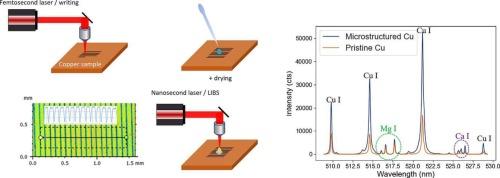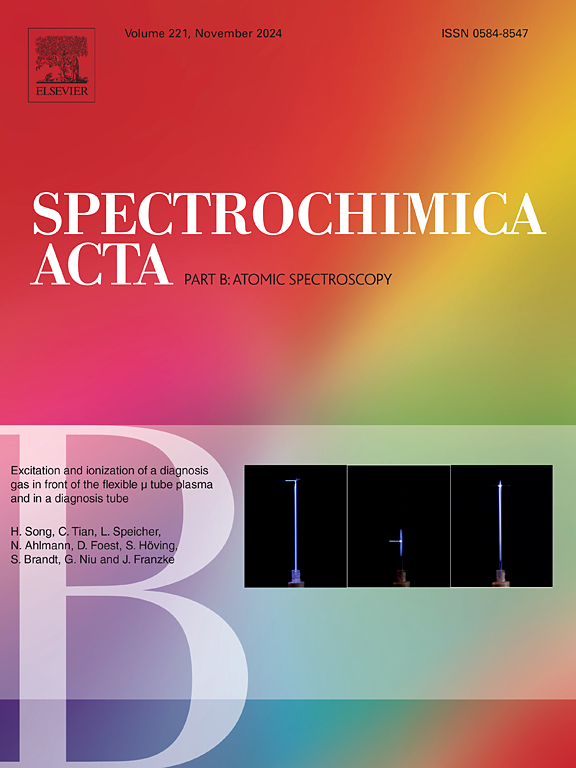铜激光表面微结构增强LIBS信号
IF 3.8
2区 化学
Q1 SPECTROSCOPY
引用次数: 0
摘要
本文介绍了铜的飞秒激光表面微结构优化,以获得LIBS信号增强。通过调整飞秒激光功率、频率和平移台速度,在深度在2 ~ 24 μm之间的铜样品上形成了周期行形式的微结构。在具有微结构的区域观察到变暗效应,对应于比抛光表面更好的光捕获效应。利用Cu I线在521.8 nm处的LIBS信号增强作为选择等离子体发射增强最大的微结构类型的指标。利用共聚焦显微镜和飞行时间二次离子光谱法对微结构进行表征,解释了不同微结构之间信号增强的变化。更具体地说,由于典型LIBS陨石坑深度内氧化铜含量较高,更深和更深的微结构提供的信号增强较少。在优化后的微结构上获得了高达11的信号增强。这种增强是由于电子密度增加了70%,温度增加了17%,等离子体寿命增加了两倍。最后,所得的微结构铜样品用作液体LIBS分析的底物。在本研究中,将矿物质水滴在衬底上干燥,发现在526.2 nm, 56.5 nm和527.0 nm处的Ca I线的LIBS信号强度大约是没有微结构的铜衬底上的4倍。本文章由计算机程序翻译,如有差异,请以英文原文为准。

LIBS signal enhancement by laser surface microstructuring of copper
This paper describes the optimization of femtosecond laser surface microstructuring of copper to obtain LIBS signal enhancement. Microstructures in the form of periodic rows are created on a copper sample with depths between 2 μm and 24 μm by tuning the femtosecond laser power, frequency, as well as the translation stage speed. A darkening effect is observed in the zones with microstructures, corresponding to a better light trapping effect than on a polished surface. The LIBS signal enhancement of the Cu I line at 521.8 nm is used as an indicator to select the type of microstructures which induces the maximum enhancement of the plasma emission. Characterizations of the microstructures through confocal microscopy and Time of Flight Secondary Ion Spectrometry are used to explain the change in signal enhancement between different microstructures. More specifically, deeper and darker microstructures are shown to provide less signal enhancement due to the higher content of copper oxide within the typical LIBS crater depth. A signal enhancement as high as 11 is obtained on the optimized microstructure. This enhancement is the result of a 70 % increase in electron density, 17 % increase in temperature and two times higher plasma lifetime. Finally, the resulting microstructured copper sample is used as a substrate for the LIBS analysis of a liquid. In this study, mineral water is dropped and dried on the substrate, and the LIBS signal of the Ca I lines intensities at 526.2 nm, 526.5 nm and 527.0 nm is found to be roughly four times higher than on the copper substrate without microstructures.
求助全文
通过发布文献求助,成功后即可免费获取论文全文。
去求助
来源期刊
CiteScore
6.10
自引率
12.10%
发文量
173
审稿时长
81 days
期刊介绍:
Spectrochimica Acta Part B: Atomic Spectroscopy, is intended for the rapid publication of both original work and reviews in the following fields:
Atomic Emission (AES), Atomic Absorption (AAS) and Atomic Fluorescence (AFS) spectroscopy;
Mass Spectrometry (MS) for inorganic analysis covering Spark Source (SS-MS), Inductively Coupled Plasma (ICP-MS), Glow Discharge (GD-MS), and Secondary Ion Mass Spectrometry (SIMS).
Laser induced atomic spectroscopy for inorganic analysis, including non-linear optical laser spectroscopy, covering Laser Enhanced Ionization (LEI), Laser Induced Fluorescence (LIF), Resonance Ionization Spectroscopy (RIS) and Resonance Ionization Mass Spectrometry (RIMS); Laser Induced Breakdown Spectroscopy (LIBS); Cavity Ringdown Spectroscopy (CRDS), Laser Ablation Inductively Coupled Plasma Atomic Emission Spectroscopy (LA-ICP-AES) and Laser Ablation Inductively Coupled Plasma Mass Spectrometry (LA-ICP-MS).
X-ray spectrometry, X-ray Optics and Microanalysis, including X-ray fluorescence spectrometry (XRF) and related techniques, in particular Total-reflection X-ray Fluorescence Spectrometry (TXRF), and Synchrotron Radiation-excited Total reflection XRF (SR-TXRF).
Manuscripts dealing with (i) fundamentals, (ii) methodology development, (iii)instrumentation, and (iv) applications, can be submitted for publication.

 求助内容:
求助内容: 应助结果提醒方式:
应助结果提醒方式:


